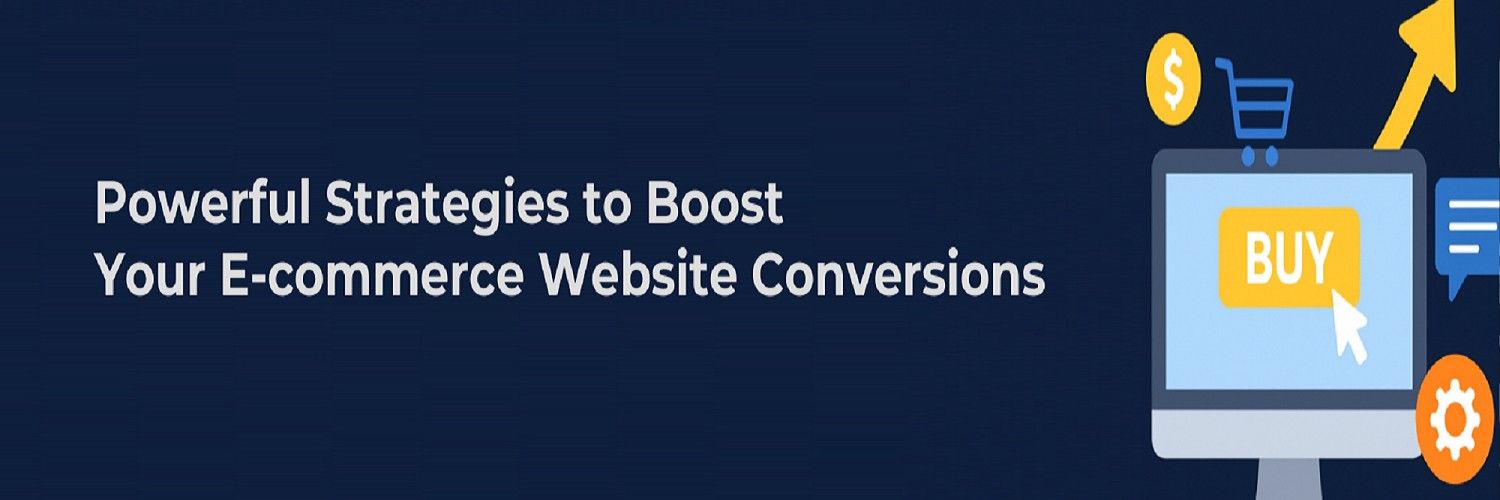
Powerful Strategies to Boost Your eCommerce Website Conversions

In today’s competitive digital marketplace, simply having an eCommerce store is not enough. Success comes when your website is optimized to turn visitors into paying customers. This process, known as conversion rate optimization (CRO), is one of the most crucial areas in digital marketing. If you want to increase sales, grow your customer base and scale your online business, you must implement powerful eCommerce strategies to boost conversions.
Understanding eCommerce Conversions: Before implementing strategies, it’s important to define what a conversion means for your eCommerce website. A conversion could be:
If your content is unclear, overly technical, or poorly structured, it may get overlooked—even if it’s accurate.
1. Optimize Website Speed and Mobile Experience: A slow website kills conversions. Studies show that a 1-second delay in loading speed can reduce conversion rates by 7%.
- Use a fast hosting solution and a content delivery network (CDN).
- Compress images without compromising quality.
- Minimize code, leverage caching, and reduce server response time.
- Ensure your website is fully mobile-friendly, as more than 65% of eCommerce traffic comes from mobile devices.
Mobile eCommerce optimization is not optional—it’s mandatory to win customers.
2. Improve User Experience (UX) and Navigation: A user-friendly website design directly impacts conversion rates. Customers must find products easily and complete checkout without friction.
- Use clear product categories and filters to improve navigation.
- Add a powerful search bar with predictive search.
- Minimize code, leverage caching, and reduce server response time.
- Ensure product pages have detailed descriptions, high-quality images and reviews.
- Simplify checkout with fewer steps and guest checkout options.
A smooth UX helps reduce cart abandonment, one of the biggest challenges in eCommerce.
3. Leverage SEO for eCommerce Conversions: Organic traffic plays a huge role in boosting sales. With SEO for eCommerce websites, you can attract high-intent visitors who are ready to buy.
- Research high-search-volume keywords like best online shopping site, buy organic products online, affordable eCommerce store, fastest delivery eCommerce.
- Add a powerful search bar with predictive search.
- Optimize product pages with keywords in titles, descriptions, and alt tags.
- Create blog content around long-tail keywords like “best gluten-free flour for diabetes” or “top fashion accessories under 99 USD”.
- Use schema markup for product pages to show ratings, prices and availability in search results.
- Simplify checkout with fewer steps and guest checkout options.
When done right, eCommerce SEO increases visibility, drives targeted traffic, and boosts conversions.
4. Use Social Proof and Customer Reviews: One of the most effective conversion strategies is building trust with social proof.
- Display customer testimonials and star ratings on product pages.
- Highlight user-generated content (UGC) from Instagram and Facebook.
- Add trust badges such as “Secure Checkout” and “100% Money Back Guarantee.”
- Use case studies and influencer endorsements to strengthen credibility.
According to surveys, 92% of online shoppers trust reviews as much as personal recommendations.
5. Personalization and AI-Powered Recommendations: Modern consumers expect personalized shopping experiences. Using AI and machine learning, you can significantly increase eCommerce conversions.
- Show personalized product recommendations based on browsing history.
- Send automated emails with discounts for abandoned carts.
- Implement AI-driven chatbots for instant support.
- Customize homepage banners for returning visitors.
Personalization boosts engagement and makes customers feel valued, increasing the chances of repeat purchases.
6. Strategic Pricing and Promotions: Your pricing strategy can make or break your conversion rates.
- Offer limited-time discounts to create urgency.
- Bundle products to increase average order value (AOV).
- Use psychological pricing techniques like 99 USD instead of 100 USD.
- Provide first-purchase offers like “Get 20% off your first order.”
By combining promotions with a clear value proposition, you can drive more sales.
7. Invest in Paid Advertising and Retargeting: While SEO drives organic growth, paid advertising campaigns deliver faster results.
- Use Google Shopping Ads to showcase products with images and prices directly in search results.
- Run Facebook and Instagram Ads targeting specific demographics.
- Retarget customers who visited but didn’t purchase with personalized ads.
- Track ad performance and optimize for high ROI.
Retargeting campaigns alone can recover up to 30% of abandoned carts.
8. Content Marketing to Educate and Engage Customers: High-quality content helps establish your brand as an authority. It also builds trust, which is crucial for conversions.
- Write SEO-driven blog posts around buyer pain points.
- Create video tutorials and product demos.
- Share recipes, styling tips, or fitness guides (depending on niche).
- Send newsletters with helpful content and promotions.
Content marketing not only boosts eCommerce conversions but also strengthens brand loyalty.
9. Optimize Checkout Process: Checkout optimization is the backbone of conversion rate optimization (CRO).
- Provide multiple payment options (UPI, wallets, credit cards, COD).
- Offer one-click checkout for returning users.
- Show shipping costs upfront to avoid last-minute surprises.
- Ensure the checkout page is secure, fast and mobile-friendly.
The fewer steps in checkout, the higher the conversion rate.
10. Monitor Analytics and A/B Testing: To continually improve conversions, you must measure results.
- Track performance using Google Analytics, Hotjar and heatmaps.
- A/B test landing pages, CTA buttons, product descriptions and ad creatives.
- Analyze user behavior to identify drop-off points.
- Continuously optimize campaigns for better ROI.
Data-driven decision-making ensures sustainable growth in your eCommerce business.
Conclusion
Boosting eCommerce website conversions requires a strategic blend of website optimization, SEO, content marketing, paid ads, personalization and data analysis. By implementing these powerful strategies, you can improve customer experience, reduce cart abandonment and increase revenue.
Remember: Every small improvement in conversion rate can lead to significant revenue growth. Whether you are just starting your eCommerce journey or scaling to the next level, these proven tactics will help you achieve higher sales and long-term success.

DO you Need some Ideas ?
I Can Help You ...
Call/WhatsApp (+91) 62038 25984

Copyright © 2025 All rights reserved | Email: umeskumar@gmail.com | Call/WhatsApp: (+91) 62038 25984
